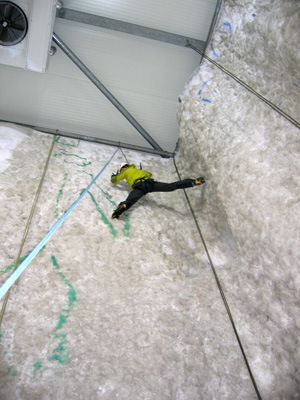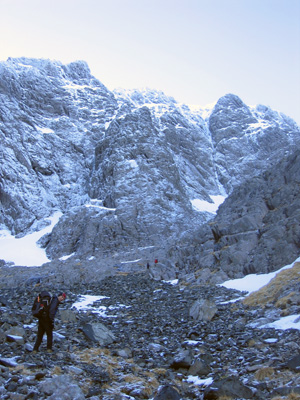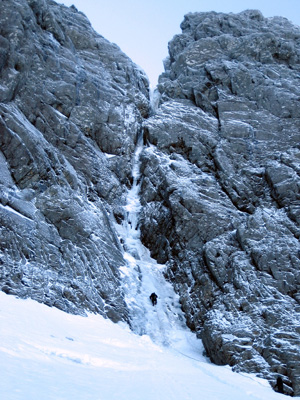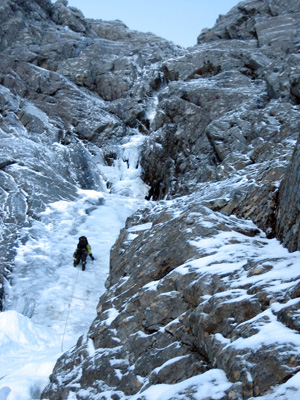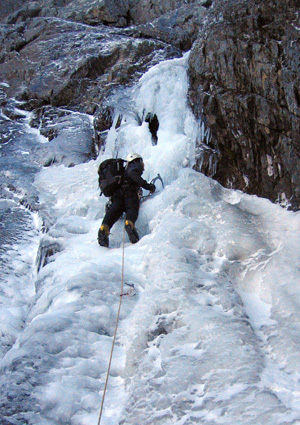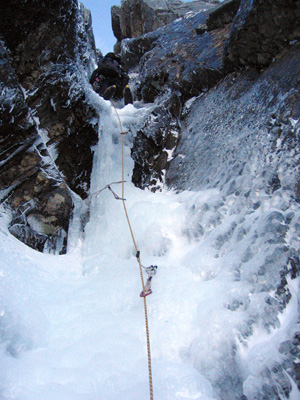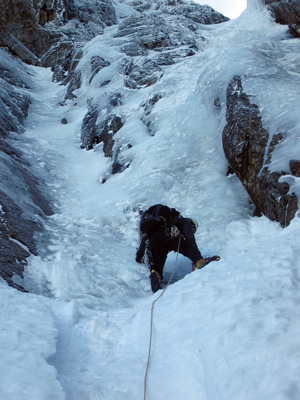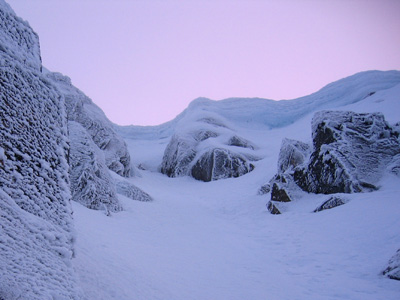Ascent of Ben Nevis (1344 m), Scotland via Point Five Gully (V, 5)February 7, 2007 (Klik her for at læse historien på dansk |
|
|
Probably the most famous ice gully in Scotland, perhaps in the world – that’s Point Five. That's the beginning of the route description in the book Cold Climbs, which Carsten P. Jensen and I had borrowed at the Danish Alpine Club library. After our friend Anders Strange also recommended the route and another guidebook writes that the route practically defines scottish 5. grade winter climbing our minds are clear - we have to climb it! We therefore fly to Glasgow early February and in accordance with our usual style we start reading our guidebooks on the aeroplane. We hoped to start with an easy route with easy access, but our research in the guidebook is without success. These don't exist in Scotland and all routes appear to be characterized by long approaches with at least a 1000 m altitude ascent in order to reach "good" ice. We thus give up our plan of an easy warm-up route and discuss alternatives as we drive the two hours from the airport to Fort William - the town at the foot of the highest mountain in United Kingdom Ben Nevis (1344 m), where most of the best winter routes are located. The Northeast face of Ben Nevis where the best routes are located. The descent via the "tourist trail" is due west on the other side of the mountain. | |
We arrive to the hotel around midnight, but luckily the bar is still open so we continue our discussions about alternatives over a pint of beer. Unexpectedly, the bartender suggests that we start out by ice climbing indoors at the The Ice Factor, which has a large ice climbing wall! As we cannot come up with a better 1 minute approach alternative we drive (30 min) to the artificial ice wall the next day. This actually turns out to be much more interesting that we'd anticipated. The ice is a funny mix of ice and snow and there are routes of all levels including competition routes. The day thus turns out to be very entertaining and a perfect warm-up for the route we had come to climb. At the same time we get a good deal of fruitful beta from the wall instructors in the center. The week before our arrival had been very warm, which had taken its toll on the lower part of the longest ice routes (including Point Five Gully, which is one of the longest with +300 vertical meters of climbing). The instructors thus stress that the ice at Point Five is very thin at the bottom, which is not what we wanted to hear - especially not from a Scotsman, as they're (in)famous for climbing thin ice. In this instance we thus interpret 'thin ice' as paper thin.
Carsten on the worlds largest indoor ice climbing wall at The Ice Factor. |
The instructors recommend climbing one of the routes higher up on Ben Nevis, which would translate into a shorter climb with an even longer approach. Bad combination - we had not traveled to Scotland to do 1200 vertical meters of approach in order to climb 150 meter of ice! So our minds are set and in the evening we thus pack our five short 10 cm stubbie ice screws, a few standard 17 cm ice screws and a mix of rock gear. The route looks pretty straightforward from the pictures we have seen and is normally climbed to the top and then walked down on the other side of the mountain. We therefore decide to only bring one 70 meter half rope and 75 meters of 5 mm static line. The latter will be used to pull down the half rope if we, against our expectations, should choose to rappel the route. A controversial weight saving solution which had recently been debated heatedly on the forum of the Danish Alpine Club - which we wanted to test in practice!
Hans on the approach to Point Five Gully seen right of the Observatory Ridge in the middle of the picture. |
We drive into the parking lot at the start of the approach at 7 AM the next morning and observe a lot of cars! Even though it is in the middle of the week Ben Nevis is still seeing a lot of traffic. We start the long walk to the C.I.S. hut which we reach almost two hours later. Most of the trail is in great condition and gradually the beautiful Northeast face comes into sight. At the hut a couple of Scotsmen help us by pointing out a couple of gullies and ridges, which help us get our bearings. Point Five Gully looks pretty good from the hut and there is ice/snow all the way to the summit! Quite a few climbers are walking up the upper slopes to the routes - I guess we should have started a bit earlier! However, there are a lot of other routes on the approach to Point Five, and to our relief most of the climbers continue beyond Point Five to reach the routes higher on the mountain. Scotchman climbing the first robe length of Point Five Gully. Move the mouse cursor over the picture to point out the three cruxes. |
We end up with only one rope team ahead of us, which is quite rare on Point Five as it often has rope teams from the first to the last of the eight rope lengths! Apparently, most teams have chosen to follow the recommendations of the wall instructors and opt for the routes high on Ben Nevis, which still have thick ice coverage. The approach from the hut to Point Five takes about an hour - first on loose rock blocks and then on a snow field with an increasing inclination (ending at around 30-40°). The leader of the rope team ahead of us is halfway up the first rope length when we reach the anchor at the base of the climb. They are locals and the second securing the leader tells us that this is his fifth attempt. The first three times he had to give up because of queues on the route and the fourth time his girlfriend got tired halfway up forcing them to retreat. He is thus quite impressed that we have chosen Point Five as our first route on The Ben! But from our point of view we just didn't want to experience the approach again!
Carsten leading the first rope length. The next anchor is on the right side of the plateau in the middle of the picture. The first crux of the route, a freestanding and thin curtain, is seen slightly above the middle of the picture. |
The scottish leader has not climbed fifth grade for several years, and he climbs sloooooowly..... The first rope length is the easiest on the route (a broad slab with an inclination of approximately 70° with relatively thick ice), so Carsten and I look a bit disgruntled at each other. Luckily, the second climbs much faster which improves our optimism as he reaches the anchor quickly and we can get started. Carsten leads the first pitch fast, however, as there is only space for one at the anchor he has to wait at an ice screw while the best scotchman climbs the first crux of the route - a thin, narrow and freestanding curtain. Soon it is my turn leading the crux on the second pitch which turns out to be very entertaining climbing. The curtain is only a couple of meters high, so I am not nervous that it could break. The gully has begun to narrow, so I can bridge out on rock covered with a thin layer of ice on the right to gain good balance.
Hans in front of the first crux (2nd pitch) - a thin, narrow freestanding curtain. |
The second pitch is relatively short, so Carsten suggests I continue up the third pitch, which surprisingly turns out to be the mental crux of the route. Already on the second pitch the route was thin and hard to protect (read - do not test your stubbies!), but it turns out to be even harder on the third pitch. The third pitch starts out with a thin freestanding pillar, which I can reach all the way around with my arms to secure the bottom with a sling. This pillar is very entertaining to climb as I can again bridge on rock covered with thin ice. Above the pillar the route continues through the most narrow part of the gully. The "ice" consists of a layer of snow covered with a thin layer of ice which I can almost just push the ice screws into!
Hans has just climbed the second crux on the route (third pitch) - a thin freestanding pillar. Note the thin ice layer on the rock which I used for bridging. |
I am misled several times to believe that I have reached a patch of good ice, but each time I am disappointed. A couple of times I let the stubbies sit in the "ice" but I know that they will not be able to hold a fall so I focus on making perfect placements with my axes and crampons each time. The rock on each side is so solid that I cannot place any gear in it, but halfway up the pitch I note an outcrop in the rock with a crack in it which looks like a perfect wire placement. I climb up to the crack and lean backwards in one axe to reach it. I cannot see the the crack, but as the wire slides into the crack it gives a feeling of a perfect placement. I thus continue upwards in the belief that the wire, as the only pro on the 40-50 meter pitch, will be able to hold a fall.
Carsten climbing the third pitch. Here we really got the feeling of climbing in a narrow gully. |
We have now reached the technical crux on the route: The Rogue Pitch, which Carsten starts leading. The beginning of the crux is easiest on the right side until the ice becomes overhanging, after which he traverses leftwards. As he reaches the traverse I can see that Carsten has an internal fight with himself - it is the first time that he leads fifth grade ice since he broke his ankle whilst leading the ice route Bourgeaux Left in Canada in 2004. I yell a couple of encouragements and to my great delight I see that he continues up the crux with a confidence I haven't seen on ice for a long while. This pitch also offers very entertaining technical ice climbing on ice that had finally gotten thicker.
Carsten leading The Rogue Pitch (fourth pitch) which is the technical crux on the route. |
Hans leading the last bit of ice on the route (fifth pitch). |
After The Rogue Pitch the route change character. The inclination drops and the surface change to snowfields with a few ice patches that can be used for ice screws.
Beautiful view towards northeast from the top of the fifth pitch. |
The snow is great as it is very firmly packed and most placements with our ice axes feel very secure. Carsten follows the fifth pitch. The route now mainly consist of snowfields which can occasionally be secured by ice screws in smaller ice patches. Click on the picture to see a short movie from the route (requires installation of Quicktime) |
We finally get some use for our 70 meter rope, as it reduces the last four pitches into three and before we know it we are standing in front of the last crux on the route: the overhanging cornice at the top. Luckily, I spot a weakness in the cornice where the snow is "only" vertical.
Carsten leading the sixth pitch. |
By the time I reach the vertical part of the cornice I am well above my last screw placement and curse a bit over our choice not to bring a snow picket.
Carsten at the anchor after the sixth pitch. |
|
It's a bit wild climbing vertical snow, but luckily it is compact and the placements feel relatively safe. I focus on distributing my weight on all four axe- and crampon placements and don't pull/push too hard on any of them. It is a great feeling to hit the axes in the horizontal top-plateau and then lift my head over the edge. The wind hits my face and I am met by the most beautiful sunset behind the emergency shelter and top triangulation point. I top out and quickly make a snow anchor with my ice axes, and soon Carsten joins me on the summit. |
The last crux on the route, the overhanging cornice, where we luckily found a weakness on the left that was "only" vertical. |
The top plateau is notoriously known for being difficult to navigate due to steep faces on all sides, except due west, which one can drop out over, so we quickly pack our things in order to get as far down as possible before it gets completely dark.
Emergency shelter (left) and top triangulation point (right) on the summit of Ben Nevis. |
|
While we mess around at the top triangulation point to take the obligatory summit photo, we almost get a shock when a lone climber appears in the dark. He has soloed another fifth grade route and asks whether he can walk down with us. This is of course OK - especially when it turns out that he knows a shortcut back to the car park, which saves us around 1 hour hiking! 14 hours after we set out we are back at the car. It has been a fantastic day on a fantastic route with a fantastic long approach and walk-out! The next day we take a deserved rest day at the Oban distillery before we return to Denmark with tired legs and a smile on our face. |
|

